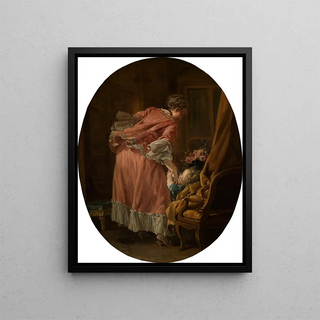Art print | The spoiled child - François Boucher


View from behind

Frame (optional)
In the vibrant world of Rococo art, "L'enfant gâté" by François Boucher stands out for its irresistible charm and exquisite delicacy. This artwork, dating from the 18th century, perfectly embodies the playful and light-hearted spirit of its era. Through the depiction of a young child, Boucher invites us to explore themes of innocence and frivolity, while offering a glimpse into the customs and values of a society in full effervescence. The scene, imbued with gentle nostalgia, captures the very essence of childhood, where pleasure and lightness reign. This painting, with its harmonious composition and pastel colors, transports the viewer to a world where happiness seems eternal.
Style and uniqueness of the work
Boucher's work is characterized by its flamboyant style and meticulous details. In "L'enfant gâté," the painter manages to create an intimate atmosphere, where each element contributes to the overall harmony. The silky drapes of the clothing, the softness of the expressions, and the gentle light enveloping the scene all testify to his exceptional talent. The pastel colors, typical of Rococo, intertwine gracefully, evoking an almost tangible lightness. Boucher succeeds in immortalizing a fleeting moment of tenderness, where the child, both mischievous and innocent, seems to flourish in a cocoon of softness. The composition, although seemingly simple, reveals an emotional depth that touches the heart and soul, making this work a true masterpiece of French painting.
The artist and his influence
François Boucher, one of the most emblematic artists of the 18th century, knew how to mark his era with his unique style and artistic vision. Raised in an artistic environment, he was influenced by the masters of Italian painting but also developed a distinctive approach. His work is often associated with the taste of the court of Louis XV, where he exerted considerable influence as an official painter. Boucher captured the spirit of his time, blending sensuality and lightness, while addressing a variety of themes

Matte finish

View from behind

Frame (optional)
In the vibrant world of Rococo art, "L'enfant gâté" by François Boucher stands out for its irresistible charm and exquisite delicacy. This artwork, dating from the 18th century, perfectly embodies the playful and light-hearted spirit of its era. Through the depiction of a young child, Boucher invites us to explore themes of innocence and frivolity, while offering a glimpse into the customs and values of a society in full effervescence. The scene, imbued with gentle nostalgia, captures the very essence of childhood, where pleasure and lightness reign. This painting, with its harmonious composition and pastel colors, transports the viewer to a world where happiness seems eternal.
Style and uniqueness of the work
Boucher's work is characterized by its flamboyant style and meticulous details. In "L'enfant gâté," the painter manages to create an intimate atmosphere, where each element contributes to the overall harmony. The silky drapes of the clothing, the softness of the expressions, and the gentle light enveloping the scene all testify to his exceptional talent. The pastel colors, typical of Rococo, intertwine gracefully, evoking an almost tangible lightness. Boucher succeeds in immortalizing a fleeting moment of tenderness, where the child, both mischievous and innocent, seems to flourish in a cocoon of softness. The composition, although seemingly simple, reveals an emotional depth that touches the heart and soul, making this work a true masterpiece of French painting.
The artist and his influence
François Boucher, one of the most emblematic artists of the 18th century, knew how to mark his era with his unique style and artistic vision. Raised in an artistic environment, he was influenced by the masters of Italian painting but also developed a distinctive approach. His work is often associated with the taste of the court of Louis XV, where he exerted considerable influence as an official painter. Boucher captured the spirit of his time, blending sensuality and lightness, while addressing a variety of themes






